Last updated: May 8, 2023
Article
Ulysses S. Grant and Julia Dent Grant at White Haven Farm: The Missouri Compromise in American Life (Teaching with Historic Places
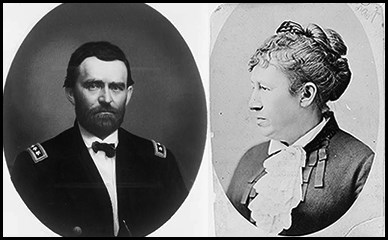
(Library of Congress)
In Missouri, in the 1840s, an anti-slavery soldier from Ohio fell in love with the daughter of a slave-owning gentleman farmer.
The soldier was a future American president, Ulysses S. Grant, and the woman was Julia Dent of White Haven. They married, and the couple spent most of Grant’s pre-war civilian years living on the Dent family’s estate: 850-acre farm that was home to Julia’s large family and up to 30 enslaved African Americans. Slaves at White Haven worked in the fields and orchards, cared for livestock and horses, cooked in the family kitchens, and served the Dent family, including Grant.
White Haven illustrates a complex chapter in the life of the man who signed the 15th Amendment into law and presided over Radical Reconstruction in the South after the Civil War. Grant was the last American president to own a slave. It was during this chapter of Grant’s life that he benefitted from the slave society he later worked to destroy, first as a soldier and then as a politician.
About This Lesson
This lesson is based on the National Register of Historic Places registration file for “White Haven (Grant-Dent House)” (with photographs); Brook Simpson’s Ulysses S. Grant: Triumph over Adversity, 1822-1865; Julia Dent Grant’s personal memoir; and materials from the National Park Service Ulysses S. Grant National Historic Site. It was written by Hannah Scanlon and edited by the Teaching with Historic Places staff in collaboration with Pam Sanfilippo, Site Historian at the Ulysses S. Grant National Historic Site. This lesson is one in a series that brings the important stories of historic places into the classrooms across the country.
Where it fits into the curriculum
Topics: This lesson could be used in units on America’s 19th-century western expansion, slavery in Antebellum America, and race in America. Students can study historic White Haven to explore the complex relations between the farm’s white family and the enslaved African Americans who lived with them.
Time period: Mid-19th century
United States History Standards for Grades 5-12
Ulysses S. Grant and Julia Dent Grant at White Haven Farm: The Missouri Compromise in American Life relates to the following National Standards for History:
Era 4: Expansion and Reform (1801-1861)
-
Standard 2D- The student understands the rapid growth of "the peculiar institution" after 1800 and the varied experiences of African Americans under slavery.
-
Standard 3B- The student understands how the debates over slavery influenced politics and sectionalism.
Era 5: Civil War and Reconstruction (1850-1877)
-
Standard 1A- The student understands how the North and South differed and how politics and ideologies led to the Civil War.
Curriculum Standards for Social Studies
(National Council for the Social Studies)
Ulysses S. Grant and Julia Dent Grant at White Haven Farm: The Missouri Compromise in American Life relates to the following Social Studies Standards:
Theme I: Culture
-
Standard B -The student explains how information and experiences may be interpreted by people from diverse cultural perspectives and frames of reference.
-
Standard C -The student explains and gives examples of how language, literature, the arts, architecture, other artifacts, traditions, beliefs, values, and behaviors contribute to the development and transmission of culture.
Theme II: Time, Continuity, and Change
-
Standard D -The student identifies and uses processes important to reconstructing and reinterpreting the past, such as using a variety of sources, providing, validating, and weighing evidence for claims, checking credibility of sources, and searching for causality.
Theme III: People, Places, and Environments
-
Standard I -The student describes ways that historical events have been influenced by, and have influenced, physical and human geographic factors in local, regional, national, and global settings.
Theme IV: Individual Development and Identity
-
Standard C -The student describes the ways family, gender, ethnicity, nationality, and institutional affiliations contribute to personal identity.
-
Standard G -The student identifies and interprets examples of stereotyping, conformity, and altruism.
Theme V: Individuals, Groups, and Institutions
-
Standard B -The student analyzes group and institutional influences on people, events, and elements of culture.
Theme X: Civic Ideals and Practices
-
Standard A -The student examines the origins and continuing influence of key ideals of the democratic republican form of government, such as individual human dignity, liberty, justice, equality, and the rule of law.
Objectives for students
1) To consider the contradictions between Ulysses S. Grant’s private life at White Haven and his public career;
2) To describe the implications of Missouri’s border state status before and during the Civil War;
3) To describe and compare the Dents’ perspectives on slavery to the lived, human experience of slavery at White Haven;
4) To analyze social justice and minorities in students’ own communities, both historically and in today’s society.
Materials for students
The materials listed below can be used directly on the computer or can be printed out, photocopied, and distributed to students. The maps and images appear twice: in a smaller, low-resolution version with associated questions and alone in a larger version.
1) Two maps of the United States and one map of White Haven;
2) Two readings about Ulysses S. Grant, Slavery in Missouri, and Recollections of Slavery at White Haven;
3) Five photos of buildings and artifacts at the Grant National Historic Site.
Visiting the site
The Ulysses S. Grant National Historic Site is located at 7400 Grant Road, Grantwood Village, Missouri. It is owned and operated by the National Park Service. The park is open daily year-round, 9:00 a.m. - 5:00 p.m. The site is closed Thanksgiving Day, Christmas Day, and New Year's Day. Free interpretive visits to the Main House are usually offered every 30 minutes beginning at 9:30 a.m. Expect the last house visit of the day to begin at 4:00 p.m. Due to preservation and safety concerns, space is limited for each time slot and tickets are required. Tickets are free and available at the Visitor Center desk. For more information, please visit the park website or call 314-842-1867.
Getting Started
Inquiry Question
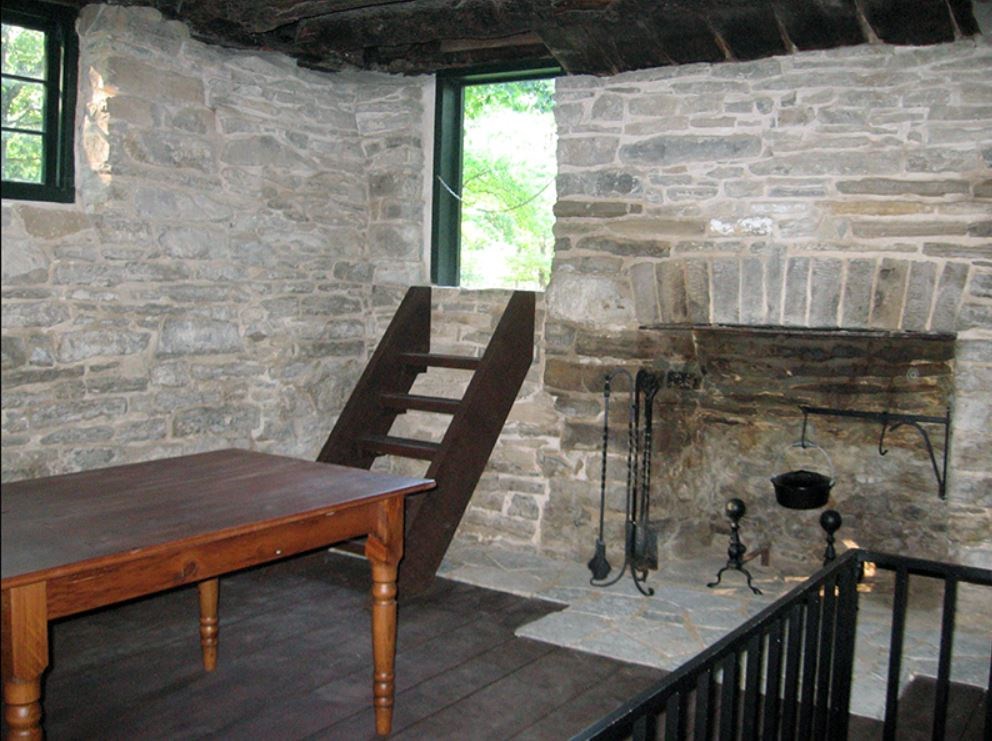
(U.S.G. National Historic Site)
Setting the Stage
The institution of slavery has long been a scar on the United States’ moral conscience. Some of the first colonial people in North America were enslaved Africans brought by Spanish and English colonizers in the 16th, 17th, and 18th centuries. During the 19th century, the descendants of these enslaved Africans were not considered people with rights by most white Americans, but rather property that could be bought and sold. These people could be forced to work unbearably long hours, underfed, physically and psychologically abused, and housed in inhumane living conditions. From young ages, they were forced out into the fields in order to make a profit for the master who treated them poorly. The culture and laws of the United States created the framework of slavery as a system of forced labor and protected the people responsible for perpetrating this abuse.
In an effort to keep the enslaved population in bondage, slave states passed laws to prohibit the education of slaves. Slave states and the federal government created laws to force people who escaped enslavement back to the plantations they tried to leave. Even if an enslaved person moved to a free state, he or she was still legally a slave under U.S. law. The most famous example of this was the Dred Scott Decision of 1857. In this decision, the Supreme Court decided that no African American in the United States, free or not, could be a full citizen. Although the experience of slavery varied by region and varied under different enslavers, the nation’s economy depended on this forced labor. Therefore, the enslavement of African Americans dictated life for blacks and whites from plantations on the Atlantic Coast to the Deep South to newly formed states in the western part of the nation. It was a national institution.
During the Civil War, Union soldiers fought to keep the country united and Confederate soldiers fought to have their own Confederate States of America where slavery could continue. In 1863, President Abraham Lincoln signed the Emancipation Proclamation. This proclamation freed the slaves in regions that were in rebellion against the federal government. In 1865, the 13th Amendment to the Constitution made slavery illegal in the United States. Many African Americans left their old masters and pursued the freedoms promised to them. Others continued to work the land where they were once enslaved, as sharecroppers under white farmers. Despite this progress, freedom from slavery did not equal freedom from racism and discrimination. African Americans continued to struggle for more than a century afterward to gain equal treatment under the law.
Locating the Site
Map 1: State Secessions, 1860-1861.
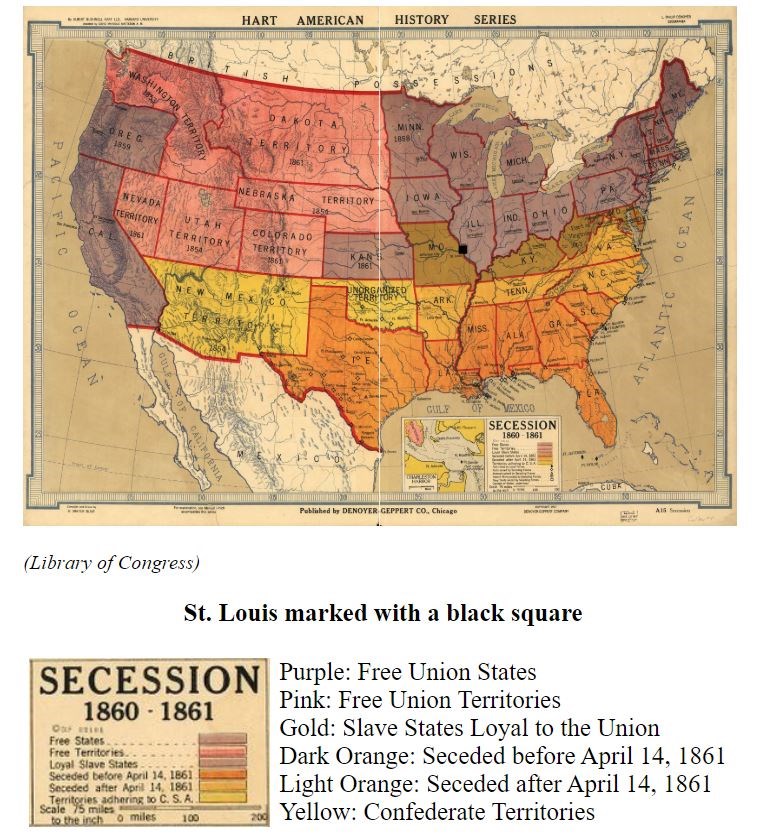
Questions for Map 1
1) Where are the Confederate slave states? Where are the Union free states? How many slave states were loyal to the Union ("border" states)?
2) Find Missouri on the map. What kind of state was Missouri at the start of the Civil War?
3) Identify the city of St. Louis, Missouri, on the map. What states is it between?
4) How might living across a river from a free state benefit people held in slavery in Missouri? How could it be different to be enslaved in a border state versus enslaved in Alabama or Georgia?
Locating the Site
Map 2: White Haven Farm, 1850s.
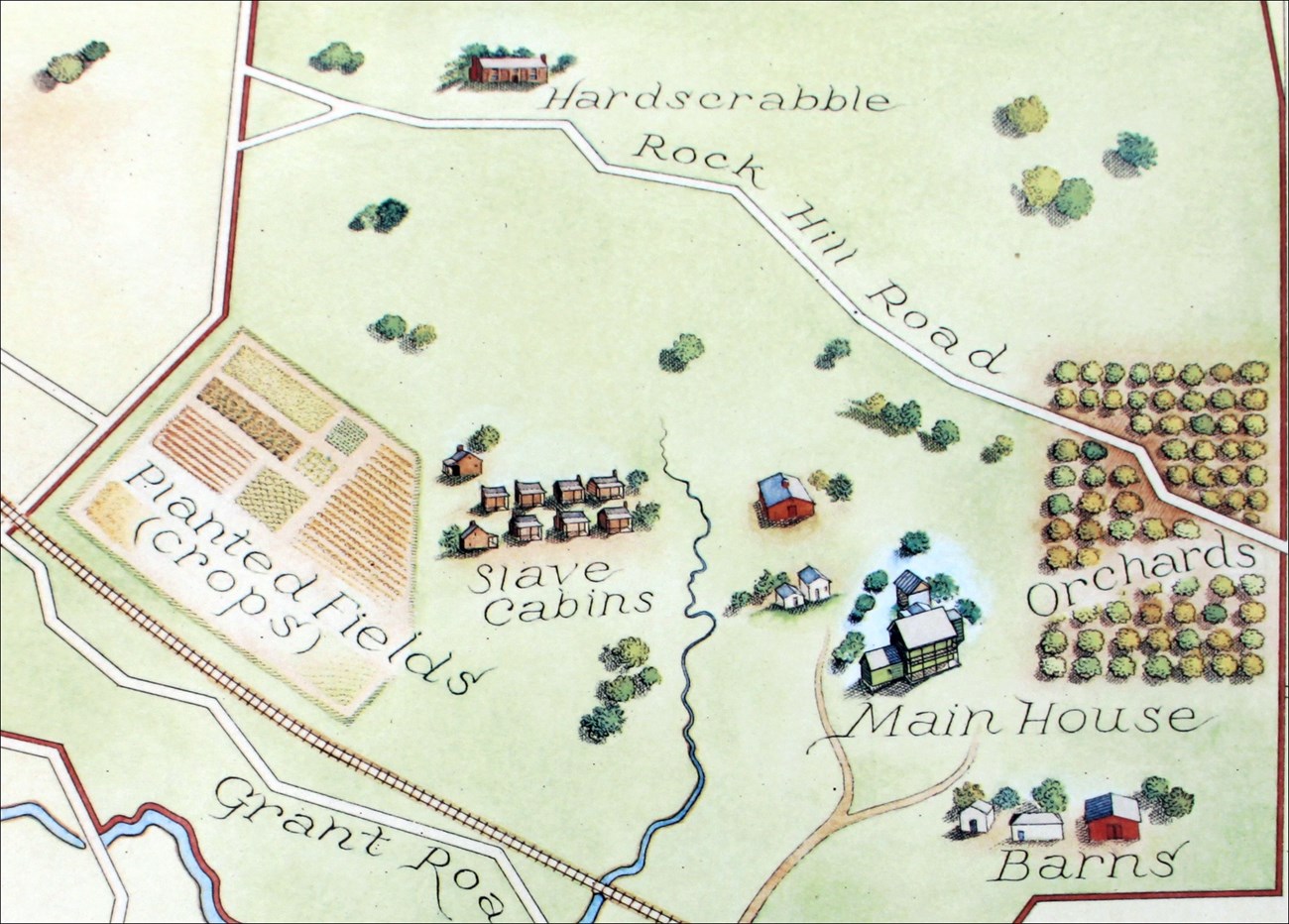
White Haven farm is located near St. Louis, Missouri. In the early 19th century, it belonged to an enslaver named Frederick Dent. Dent’s daughter, Julia, married a future U.S. president, Ulysses S. Grant. Ulysses and Julia lived at Hardscrabble, a house on the property, in the 1850s.
Questions for Map 2
1) What buildings do you see on the map? List them.
2) Who do you think lived at White Haven? In what buildings did they live?
3) What kinds of work do you think the enslaved residents did outdoors? What evidence makes you think so?
4) What kinds of work might an enslaved person at White Haven done inside the main house?
Determining the Facts
Reading 1: Ulysses & Julia
Ulysses S. Grant was a Union general during the Civil War and the 18th President of the United States. It was Grant who accepted Confederate General Robert E. Lee’s surrender, which ended the Civil War, and who oversaw the Reconstruction of the South as president. But twelve years before he signed a Constitutional Amendment that gave black, male citizens the right to vote, he lived and worked alongside enslaved African Americans on a farm near St. Louis, Missouri.
White Haven farm was the childhood home of Grant’s wife, Julia Dent Grant. Julia’s father, Frederick Dent, bought 850 acres of land and named it White Haven in 1820. It was around this time that Missouri became a slave state and Frederick Dent had the enslaved people in his household work the land at White Haven. The Dent children grew up with enslaved people cooking their meals, cleaning their house, and working on the farm. Julia’s father taught her to view slavery as a natural way of life and Julia grew up surrounded by people her father held in bondage.
Grant grew up in an anti-slavery family in Ohio, which was a free state where it was illegal to buy and sell slaves. His father was very outspoken against slavery and taught young Ulysses that it was morally wrong. Grant left Ohio to attend the United States Military Academy in West Point, New York, and graduated in 1843. That year, the U.S. Army sent him to Jefferson Barracks, a large military post near St. Louis, Missouri. His former academy roommate, Fred Dent, invited Grant to his family home at White Haven and Grant began to visit the farm regularly. It was during these visits that Grant fell in love with Julia Dent, his former roommate’s sister. Grant asked her to marry him in 1844, before he left to fight in the U.S. - Mexican War. They married in 1848 when Grant returned from the war. Julia’s father gave them 80 acres of White Haven as a wedding gift. After six more years in the Army, when he was sometimes separated from Julia, Grant resigned to be with his wife and two children in Missouri.
The Grant family lived in several houses on the large farm between 1854 and 1859. One house was Hardscrabble: a log cabin with a small farm. Grant and the enslaved men at White Haven built Hardscrabble on the land that Julia’s father gave to Grant. The family lived at Hardscrabble for several months before they moved back into the Main House after Julia’s mother passed away. They also lived for a short time in a house Julia’s brother built, called Wish-ton-Wish. When he wasn’t helping his father-in-law manage the farm, Grant worked hard to take care of his family and struggled to pay his debts. One way he earned money was by cutting timber and selling it for firewood in St. Louis. He owned one slave, purchased from his father-in-law in the late 1850s, a man named William Jones. Grant freed Jones in March 1859.
The Civil War started in April 1861 and Grant immediately reenlisted as a Union officer. He rose through the ranks as the war progressed and was Lieutenant General by the end of the war. In 1868, he ran for president and won. While he was president, the government created many programs to help freed people and laws to protect African American liberty. One of the most-significant ones was the 15th Amendment, which protected the right of black men to vote.
Grant and Julia wanted to return to their life at White Haven after the war. Grant never did, but over the course of the 1860s and 1870s, he purchased portions of White Haven until he owned the entire farm. He lived in the District of Columbia and in New York City, and traveled the world, but visited White Haven about once a year. Grant transferred ownership of his beloved White Haven in 1884 to pay off a loan. In the early 1900s, new owners split up the large property. In 1989, about 10 acres of historic White Haven, including the main house, became a unit of the National Park Service. Today, it is a place where people can visit the home of America’s 18th president and learn about the experiences of all of its 19th century residents.
Questions for Reading 1
1) How were the childhoods of Ulysses S. Grant and Julia Dent different?
2) When did Ulysses and Julia marry? Why did they move to her childhood home?
3) What might be a reason Grant bought William Jones from his father-in-law? Why do you think Grant freed William Jones when he could have sold him?
4) Why do you think someone like Grant, who was against slavery, would own a slave in Missouri during the 1850s?
Determining the Facts
Reading 2: Slavery at White Haven
Missouri became a slave state around the time Frederick Dent purchased the property he named White Haven in 1820. Before it was a state, Missouri was a territory with a mixture of cultures influenced by the free states in the North and slave states to the South. In Missouri, Southern sympathizers met Northern beliefs. When Missouri drafted its Constitution, anti-slavery and slavery supporters were at odds with each other about the acceptance of the institution in the state. Ultimately, Missouri was admitted as a slave state after the Missouri Compromise of 1820.
Missourians in different parts of the state varied in their use of slavery. Many slave owners lived near the center of the state along the Missouri River and this region came to be known as “Little Dixie,” a term used to show its ties to the South. The south-eastern part of Missouri, called the “bootheel” because of its shape, also became a hub of slavery. This “bootheel” region produced a lot of cotton and other crops that made forced labor a perceived necessity in the region. Other parts of the state did not have the same concentration of slaves as these two regions. St. Louis had a relatively small slave population that grew smaller during the years before the Civil War.
Though not located in the state’s slave-heavy regions, White Haven was a large farm by Missouri standards and had a large population of enslaved African Americans. In the 1850s, there were up to 30 people living and working on the farm’s 850 acres. Many of the enslaved residents grew up alongside Julia Grant at White Haven. As children, the young Dents and enslaved children played together. As adults, the enslaved people worked for the Dents on the estate. White Haven had fields, orchards, and livestock where slaves farmed every day for Frederick Dent. Frederick Dent and his sons were “gentlemen,” who oversaw the labor of the enslaved workers and the business of running a large farm. Slaves also worked at the Main House. Ellen Dent, Julia’s mother, was the mistress of White Haven and managed the domestic labor. She oversaw enslaved women who cooked the Dents’ meals, cared for the young children, and kept the house tidy. Most, if not all, of the slaves at White Haven slept in small, rough cabins away from the main house where the Dent family lived.
By the end of the 1850s, for many St. Louisans and Missourians Northern beliefs began to trump the politics of those sympathetic to the South. Soon, the debate over slavery raged on in the most serious of all forms: a Civil War that divided the nation and its families, and destroyed the lives of so many Americans in the name of slavery. Missouri did not secede, or join the Confederate States of America. It was a border state. It remained with the United States despite being a slave state. Relatives of the Dent family fought on both sides during the war.
Questions for Reading 2
1) In what part of the state did most enslaved Missourians live? What states did this part border? (Refer to Map 1)
2) Was White Haven in the bootheel? How many enslaved people lived and worked at White Haven? Was this common for the St. Louis region?
3) How was the life of a Dent at White Haven different from the life of an enslaved person at White Haven?
4) Why do you think Missouri did not secede?
Visual Evidence
Photo 1: 19th Century Photo of White Haven Main House.
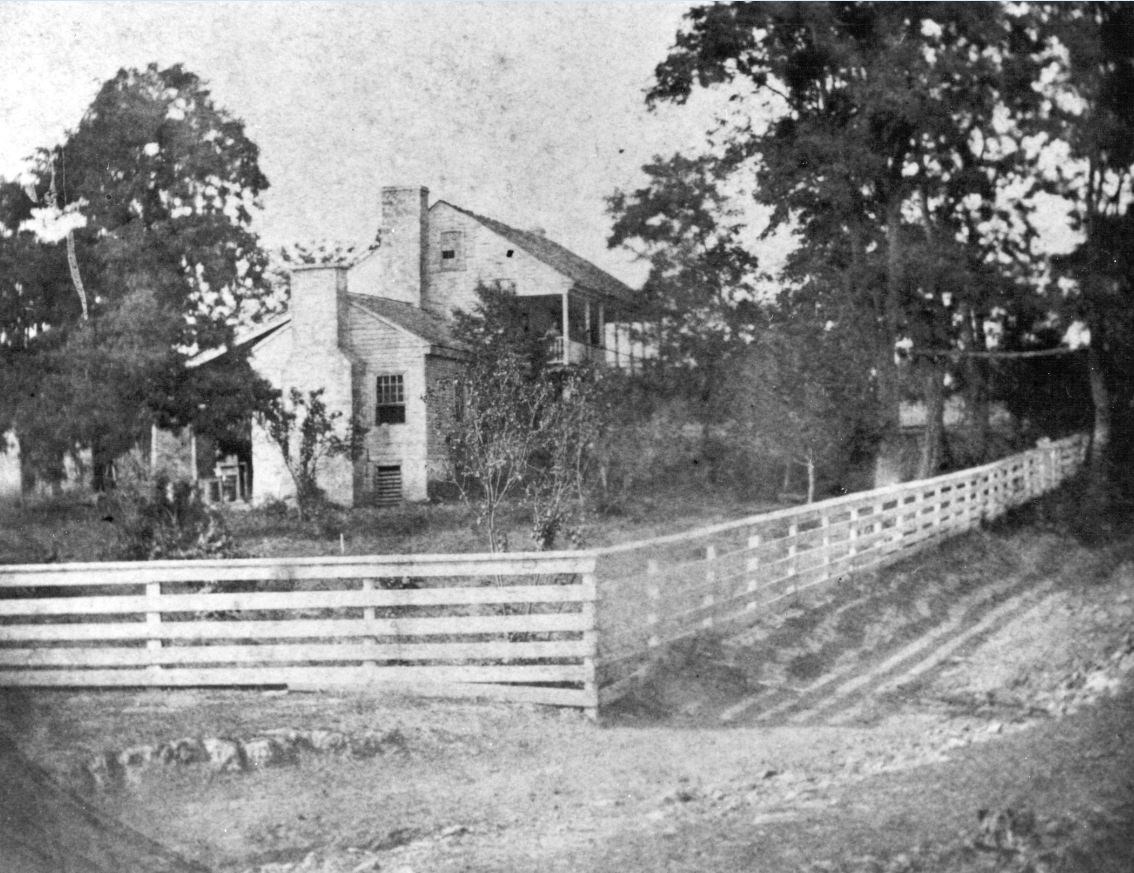
Questions for Photo 1
1) What kind of building is this? How many stories does it have? What kinds of rooms do you think it has? Is it important? Why? (Refer to Map 2 if necessary)
2) How do you think the Dents and Grants used this building? How do you think White Haven's enslaved residents used this building?
3) In what places seen in this photo do you think White Haven's enslaved residents worked? What kinds of work do you think they did in those places? Why do you think so?
Visual Evidence
Photo 2: Exterior of the Summer Kitchen and Laundry Building.
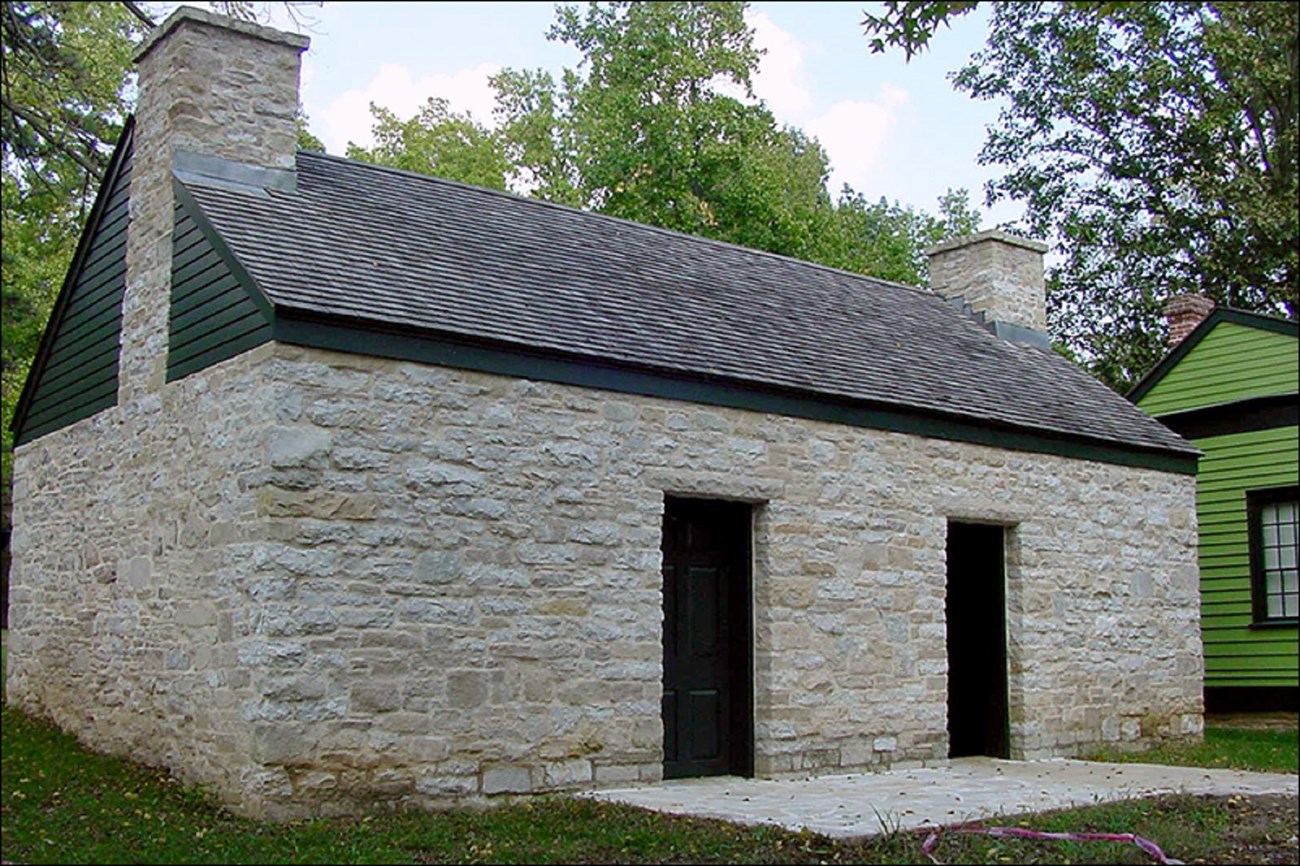
This outbuilding housed both the kitchen and laundry spaces for the Main House. Fires made in this building cooked food and heated water for laundry.
Photo 3: Interior of the Summer Kitchen and Laundry.
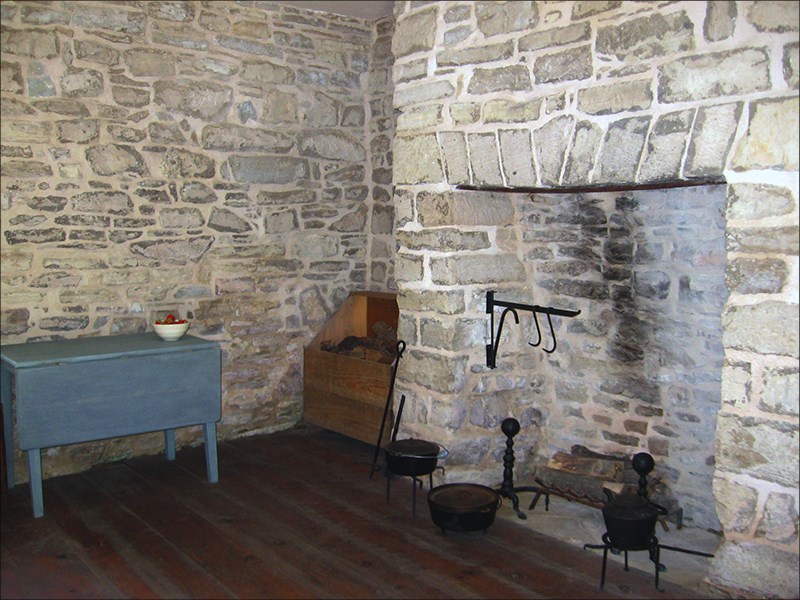
Questions for Photo 2 and Photo 3
1) What uses did White Haven’s residents have for this building? Who do you think usually worked here?
2) What type of working conditions do you think people experienced in this building in the summer?
3) Compare what you see in Photo 2 with what you saw in Photo 1. How are the buildings different? Why do you think these buildings are different?
4) Why do you think Julia would enter this building? Why do you think Mary Robinson would enter this building? How do you think these women each felt about this space? Why?
Visual Evidence
Photo 4: White Haven Basement and Winter Kitchen Interior.
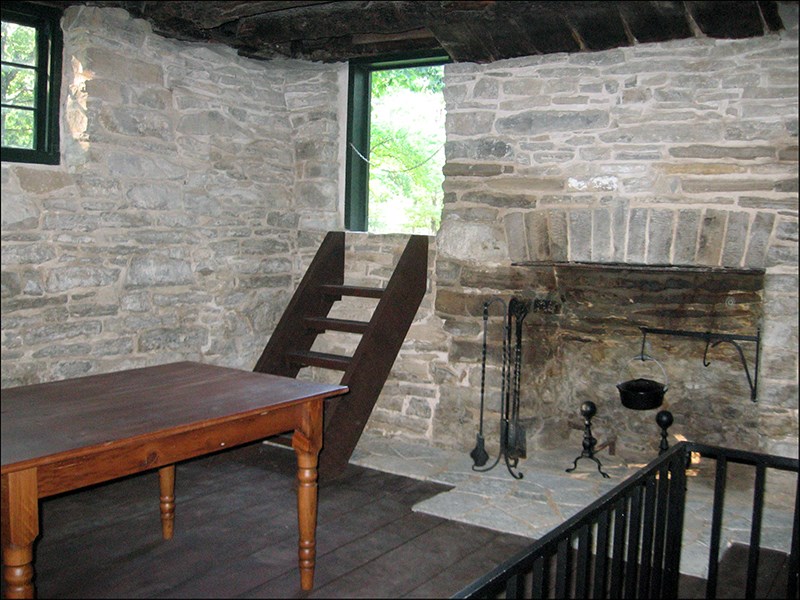
Questions for Photo 4
1) Compare Photo 4 with Photo 1. Where in Photo 1 is the entrance to the room in Photo 4? Why do you think so?
2) Who do you think worked in this room? What kinds of work did they do here?
3) Compare Photo 4 with Photo 2 and Photo 3. How are these spaces different? How are they similar?
3) Why do you think the Dents moved the kitchen work to this space in the winter? Who do you think benefitted the most from this arrangement? Why?
Visual Evidence
Photo 5: Artifacts from the Summer and Winter Kitchens.
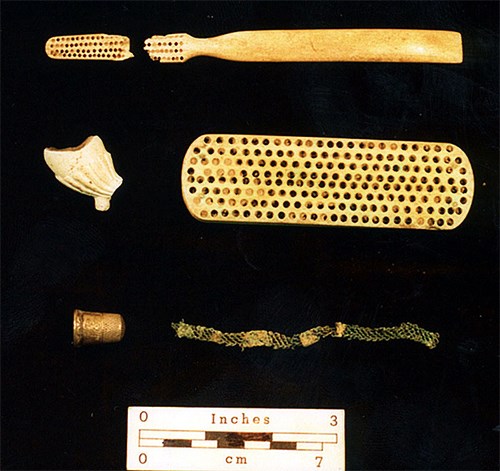
Artifacts found by archeologists during an excavation of White Haven’s summer kitchen include a toothbrush and bone hair brush. Artifacts found in the winter kitchen include the clay tobacco pipe bowl, thimble, and brass chain.
Questions for Photo 5
1) Look at Photo 5 and find each of the items named in the caption. Who do you think owned these items? Why?
2) What do these items tell us about the lives of slaves at White Haven? What kinds of activities are they each associated with?
3) How do you think an enslaved person at White Haven could have obtained items like the ones shown in Photo 5? Why do you think so?
Putting It All Together
In this lesson, students learned about life on a 19th-century Missouri farm and the complexities of social organization, political compromise, and sometimes tense relationships between Americans-- free and enslaved-- in the United States before the abolition of slavery. Use the following activities to take your students further in their study of human and political rights, American minority struggles, how historians use evidence to study the past, and how the struggles of Grant's time relate to contemporary social issues.
Activity 1: Consider the Evidence, Evaluate the Perspectives
This two-part activity has students think about evidence like historians and then use that evidence to create a piece of historical fiction. Ask your students about the different ways they have learned about slavery at White Haven in this lesson. Their answers can include the buildings, objects, maps, readings, images, and their own analysis. Have students work in small groups to go through the lesson plan and create a chart to record information about what slavery was like at White Haven. On one side of the chart, students should list relevant words/information about slavery that they find in the written materials. On the other side of the chart, students will list insights they discovered from the maps, photographs, and artifacts.
When students are done, hold a class discussion about differences and similarities between written and visual materials. Also discuss the different expectations of whites and African Americans at White Haven. Use the discussion to emphasize both the value of consulting multiple sources of evidence and also of considering different points of view when researching the past and drawing conclusions.
Next, have your student groups use the information they recorded to write a play about the lives and work of enslaved people at White Haven. Most written documentation about slavery comes from the white perspective at White Haven, so students will have to consider all of the evidence critically. They will use what was provided in the lesson to write the play's plot and dialogue, which should touch on the types of work done, living conditions, people White Haven’s slaves interacted with, and African American culture during slavery. When writing dialogue for characters at at White Haven, students must include key words listed in the table below. Have students submit a written copy of their play's dialogue and have the groups perform their plays for the class, the school, or the students' parents.
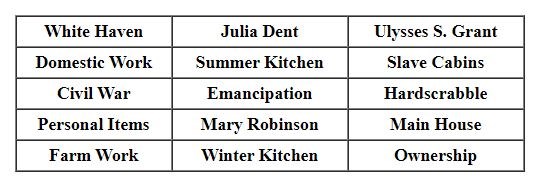
Activity 2: Experiences of Americans' Enslavement
Have each student explore first-person accounts of slavery to research the slave experience in one state other than Missouri. As students have learned, slavery varied from region to region, master to master, and plantation to plantation. Reading about what African Americans experienced in other parts of the country provides a more complete understanding about slavery.
First-person accounts of slavery can be found at the Library of Congress website, where students can find testimonies recorded and transcribed during the 20th century. Transcripts of testimonies taken during the Great Depression can be found here. Additional audio recorded testimonies and transcripts can be found here.
After the students listen to and/or read the accounts, have each student make a list of ways the slave experience in the testimony they studied was different from or similar to what slaves lived through at White Haven. Students should note living conditions, working conditions, relationships between master and slaves, and psychological effects of slavery. Each student should write a paragraph comparing and contrasting the two experiences. Students should share their responses in a class discussion about why these experiences varied.
Activity 3: Modern Compromise
Ulysses S. Grant faced a dilemma when he lived at White Haven: he was anti-slavery, but lived and worked alongside the slaves, and even acquired one slave. Use this dilemma as a starting point for students to examine conflict between a person’s beliefs and a person’s actions.
Have your students each write a 1-2 page essay that explores the following question: How do you benefit from a controversial practice in our world today? Assign each student a controversial practice to research and write about. Examples of issues might include deforestation of old-growth forests, low-wages for service-industry workers, dangerous working conditions in Chinese factories, mountaintop removal in coal mining, and elephants in circus shows. Each essay should include a description of the controversial practice, the major arguments for and against it, the place or kinds of places associated with this practice, and the student’s reflections on how the practice might touch on his or her private life. Finally, have students to present their findings to the class in an oral report.
Activity 4: Minority Rights and Justice in Grant's era and in yours
Have students explore social justice today in relation to the groups President Grant advocated for during his presidency. First, have students work in groups to research Grant’s role in protecting and supporting certain minorities in the country. One possible source of information they can review is the Messages and Papers of the Presidents at the University of Pennsylvania online. Each group should be assigned one of the following: African Americans, Native Americans, Chinese Americans, and women. After doing this preliminary research, each group should share their findings with the class in a brief presentation.
Students should then investigate minority groups today in their own communities. Using the most recent census records available here, students should determine what minority groups are present in their communities. Are they similar to the groups Grant was supporting in the 19th century? Are there any different minority groups in your community than there were in the 19th century?
Working in groups, have students choose one minority group that lives in their community to research. Next, have students trace that minority’s history in the United States using earlier census records, amendments, laws, voting rights, wages earned, and news articles. Have them organize their research as a timeline in a computer presentation to show to the rest of the class. In this presentation, they should address the following questions:
- In what ways do you think the minority group mistreated by other Americans?
- What negative things do you think the minority group experience?
- What positive things do you think the minority group experience?
- How do you think the minority group treated in your community compared to the privileged groups?
- Do you think the minority group has achieved equality in your community? Why or why not?
- What do you think could be done for the minority group to achieve fair and equal treatment?
- What places in your state or region is this group associated with? Are any of these places considered historic? Why do you think they are historic? If there are no places associated with this group that are considered historic, why do you think that is?
